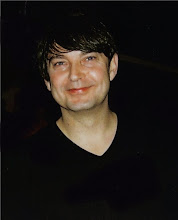A meandering asphalt path runs through the Chesley riverside park, past the red brick building, past the thick brush with the twisted tree, and up a hill towards the trails. On the rivers edge near the brush, our Great Dane, Tyrus, tail wagging, walked out with a live beaver in his mouth. As the asphalt gives way to the more natural trail, lined with rotten leaves and the wonderful aroma of decay, there are the sounds of woodpeckers and an old barn, aged dark brown and housing a family of skunks. Before the small bridge lies the ruins of the furniture factory, a tell tale remnant of industry and entropy. A reminder that everything decays, be it leaves or iron. There is enough there to weave a wonderful story of lives now completed.
Across the bridge lies a decision. Up to the left below the old railroad bridge or to the right, a longer trail leading up and over the hill to the cemetery. The path to the cemetery, we all must take at one time or another. Cement structures line both sides of the path, hundreds of them peeking out from the forest floor, extending in fairly straight lines as if part of a neolithic monument. Someone has placed large heavy boulders on top of many of these structures emphasizing this thought. In Britain, such stone markers signify ley lines or energy lines beneath the earth.
http://www.mystical-www.co.uk/leylines.htmSometimes these lines extend for hundreds of miles. These structures however, mark the foundation of the old factory with many of the old timbers and planks now overgrown. If one looks well enough, old shovels, bottles, mattress springs, and tools start to come to life from beneath the earth.
Further down the trail the sound of the river becomes louder only to quiet as you climb the steep hill to the cemetery. The rows of gravestones above the hill speak of the history of this small village, names like Krug, Johnson and Emke repeat for eternity. Past the tall trees lining the small cemetery road there lies a grave dedicated to a young boy who died at thirteen years of age, not that long ago, a hockey fan. A reminder of how fragile and cruel life can be. Clasped hands reach from above to those below, carved from limestone and aged green and brown. Through a further line of trees and beyond the cemetery is the narrow railroad bridge with its dizzying height and spectacular view of the river as it winds its way towards McClure’s Mill built by William Elliot in 1886. From this height the submerged lumber and long forgotten trees can be seen nestled in the sediment below.
The path to the left leads below this bridge, past more foundation stones and until recently, past the remains of an old work truck perhaps sixty or seventy years old, rusted and in pieces. A storehouse of forgotten memories, a playground for children, but I trust the fear of liability has removed it for eternity, the victim of modern paranoia and progress. This path dotted with purple periwinkle winds its way up and onto a road which leads over a small narrow bridge and one of the most beautiful spots on earth. The Mill sits, leaning precariously on a beam of wood, as the river calms just before a small damn. Two swans and their constant companion, a Canada Goose, swim gracefully in this calm water. Around the front of the mill, basking in the sun, lie the mill cats, sometimes up to ten or twenty of them unamused by the old Amish man unloading his buggy. A little further past the mill, past the cows and the more independent cats, you will find me standing, wondering!
 Breaking down in Villahermosa in Eastern Mexico near Veracruz, may seem like a drag, but it also has a silver lining. Villahermosa is home to a really large collection of Olmec heads as well as a massive collection of lesser known Olmec sculptures. These sculptures are massive and heavy and are the oldest monuments in pre-hispanic Mexico dating from between 1200B.C.E. and 600CE. http://www.crystalinks.com/olmec.html .
Breaking down in Villahermosa in Eastern Mexico near Veracruz, may seem like a drag, but it also has a silver lining. Villahermosa is home to a really large collection of Olmec heads as well as a massive collection of lesser known Olmec sculptures. These sculptures are massive and heavy and are the oldest monuments in pre-hispanic Mexico dating from between 1200B.C.E. and 600CE. http://www.crystalinks.com/olmec.html . Figures range from representations of monkeys to dolphins and holy men living in caves. Surprisingly, many of the figures reflect modernist principles of simplicity and abstraction.
Figures range from representations of monkeys to dolphins and holy men living in caves. Surprisingly, many of the figures reflect modernist principles of simplicity and abstraction.

 Many of the heads are 8 feet tall or more and were buried beneath the jungle until found.
Many of the heads are 8 feet tall or more and were buried beneath the jungle until found.










